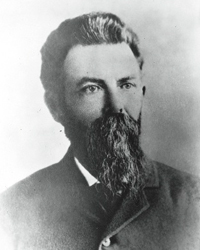19th-Century Southern States Mission Produced Men of Faith
Contributed By By Michael Ann McKinlay, Church News staff writer
.jpg)
Missionaries from the Southern States Mission.
Article Highlights
- The missionaries traveled without purse or scrip, relying on God and local hospitality for food and lodging.
- Several of the missionaries went on to become notable Church leaders, including George Albert Smith, LeGrand Richards, and Karl G. Maeser.
- During the 1875–1898 period, 1,760 elders baptized 3,839 people in the South.
“Nineteenth-century missionary life was physically, emotionally, and spiritually taxing. … Their examples of hard work, diligence, duty, courage, faith, and perseverance are inspiring.” —Heather Seferovich, Men and Women of Faith Lecture Series
Related Links
“Throughout the late 19th century, missionaries serving in the South encountered every imaginable situation in their travels,” Heather Seferovich said at the Men and Women of Faith Lecture Series in the Assembly Hall on Temple Square on November 14.
The lecture, titled “Faith to Persevere—the Southern States Mission, 1875–1898,” explored the journals and letters from missionaries who served in the South during the reconstruction period of the United States. Sister Seferovich’s research was designed to get a glimpse of the life of a 19th-century missionary, including Southern climate, diet, preaching, hospitality, and hostility.
Brigham Young organized the Southern States Mission in 1875 when he assigned eight men to fulfill a mission to the American South, Sister Seferovich explained. Some of the missionaries who served during this era went on to become future Church leaders. Those included Karl G. Maeser, John Morgan, LeGrand Richards, B. H. Roberts, and George Albert Smith.
Elders who served in the South had to adjust to the climate, diet, and customs as about 71 percent serving were from Utah, she explained. Elder John H. Gibbs wrote about the conditions in his journal: “I tell you it is hot, hot, hot. I take off my shirt at night and when I drop it down it drops like a dishrag and remains wet all night.”
Sister Seferovich explained that the elders’ main mode of transportation was walking between 1 and 20 miles a day, without purse or scrip, and “the 19th-century Mormon missionaries believed they were to depend on God's mercy and the generosity of the people they encountered for food and lodging. Many Southerners proved to be hospitable hosts.”
These circumstances produced powerful faith in the missionaries. “The great majority of men with few exception cannot exercise the same faith when provided with plenty of money as can the poor, humble servant of God who feels he is no better than his Master,” Sister Seferovich said.
This type of travel and lodging was also an effective missionary tool as the elders met with the families intimately. Through her research, Sister Seferovich found that the missionaries managed to receive enough food and slept indoors more often than outdoors.
The subjects the missionaries taught included the following: the Fall, the Apostasy, the kingdom of God, faith, repentance, the Holy Ghost, the necessity of baptism, the Book of Mormon, the Articles of Faith, the Restoration of the gospel, and the organization of the Church.

B. H. Roberts served as a missionary in the Southern States Mission and later on became the President of the First Council of Seventy. Photo courtesy of Church History Library.

John Morgan served as a missionary from 1875 to 1877 and returned to become mission president of the Southern States Mission in 1878. Photo courtesy of Church History Library.
One of the incidents Sister Seferovich recounted was that of John Morgan and a “miraculous healing that occurred.” Elder Morgan was preaching to a congregation and noticed some members were missing from a family he was acquainted with. They were unable to make the meeting because their son was sick. Elder Morgan said he had a message for them. They traveled all night to the house and arrived at 3:00 a.m. The sick boy had actually died several hours previously. Elder Morgan prayed, blessed the boy, and raised him back to life. The boy went to school the following day, and the teacher couldn't believe it was the same boy sitting on the fence, after hearing that he passed away the previous night.

Missionaries serving in the Southern States Mission while Elias S. Kimball was mission president (1894–1898) at Lookout Mountain, Tennessee. Photo courtesy of Church History Library.
However, with Southern hospitality came Southern hostility and violence. Sister Seferovich explained that the hostility ranged from written threats and harassment to physical assault, to forced expulsion, and even to attempted and actual murder.

Sister Seferovich speaks during the November 14 Men and Women of Faith Lecture Series, titled “Faith to Persevere—the Southern States Mission, 1875–1898.” Photo by Michael Ann McKinlay.
